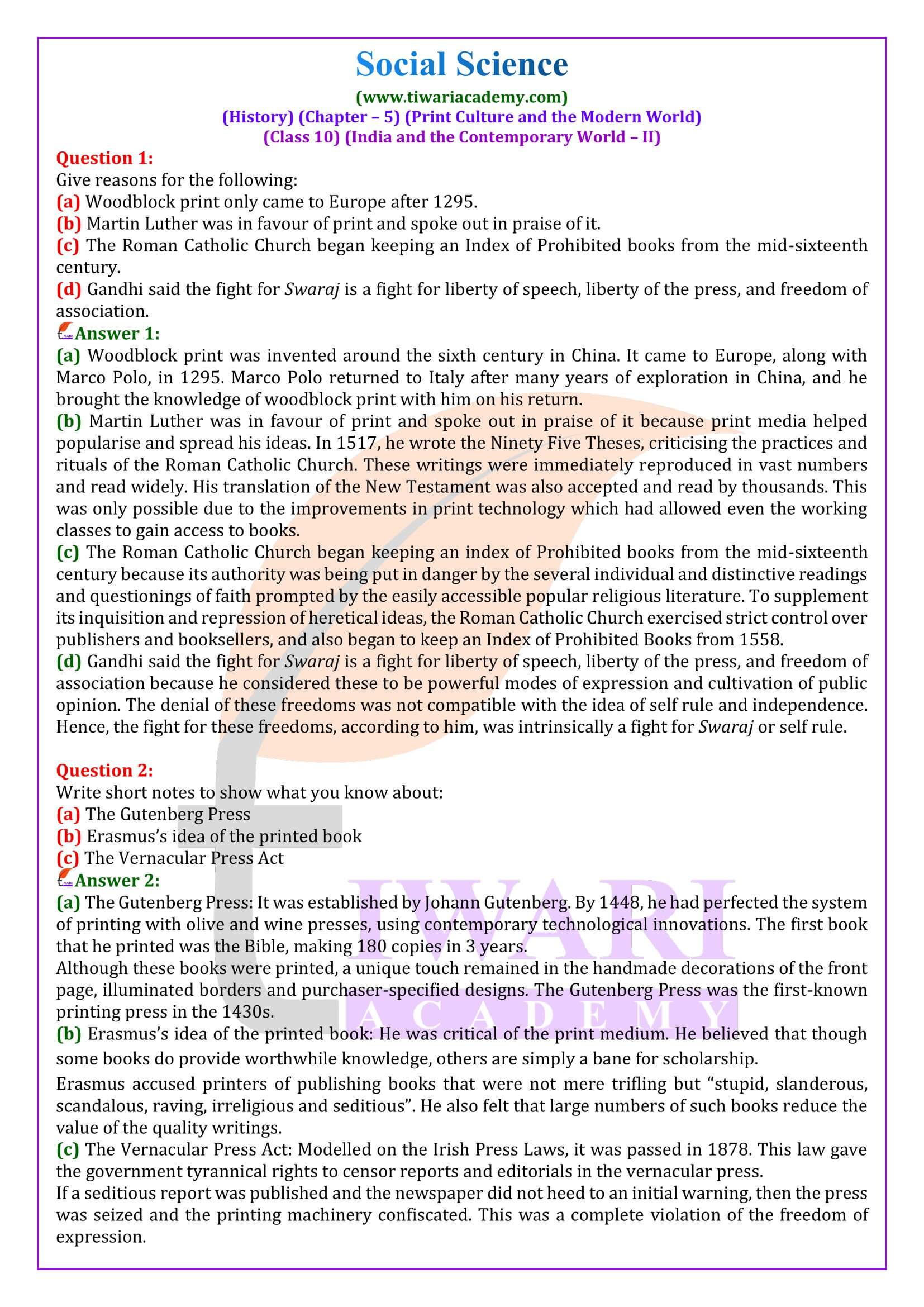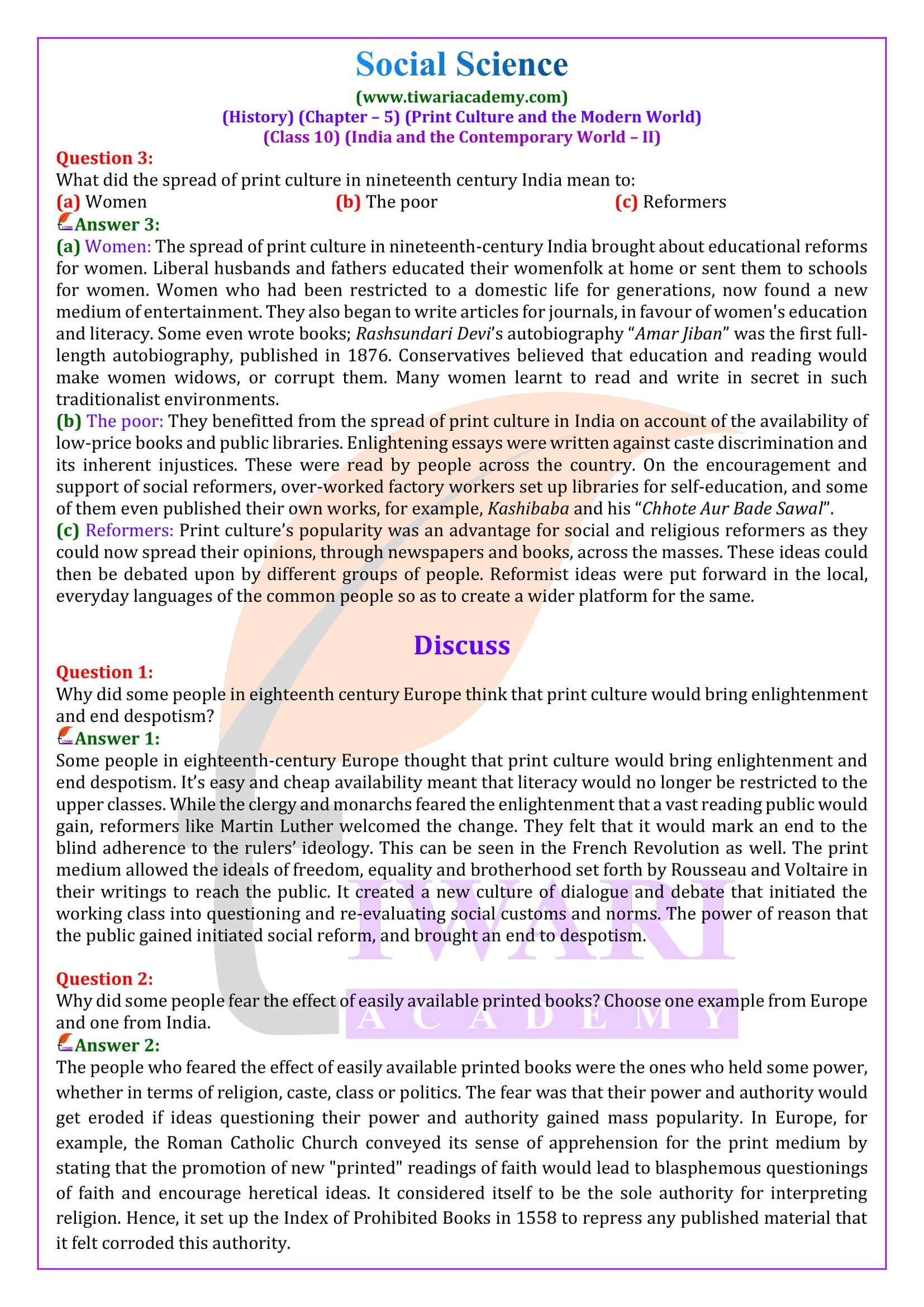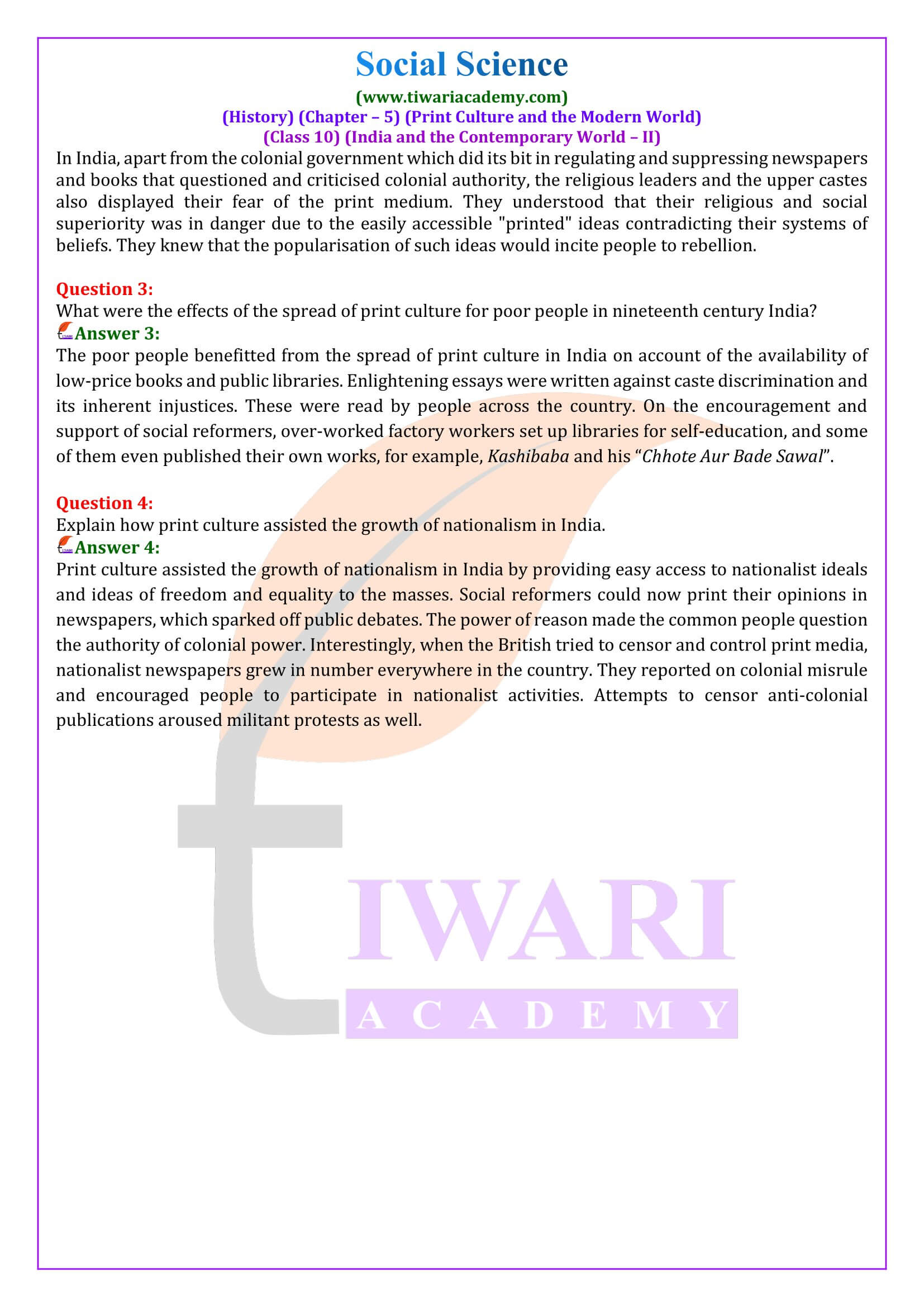NCERT Solutions for Class 10 History Chapter 5 Print Culture and The Modern World in Hindi and English Medium updated for academic session 2025-26 updated according to new CBSE Syllabus and latest NCERT Books. Download Important questions, sample papers, previous year question papers with solutions and study material in PDF form free.
NCERT Solutions for Class 10 History Chapter 5
NCERT Solutions for Class 10 History Chapter 5
| Class: | 10 |
| Subject: | Social Science – History |
| Chapter 5: | Print Culture and The Modern World |
| Session: | 2025-26 |
10th History Chapter 5 Print Culture and The Modern World
NCERT Solutions for Class 10 History Chapter 5 in PDF form to free download is given below. All the solutions are updated according the new NCERT Books and latest CBSE Syllabus. Download Apps based on updated NCERT Solutions.
Exatra Questions Class 10 History Chapter 5
What was the effect of print revolution?
Printing reduces the cost of books, the time and labour required to produce each book came down. Multiple copies could be produce easily. Circulation of ideas and open new world of debate and discussion. Brought new intellectual atmosphere, helped spread the new ideas that led to reformation. Individual interpretation of faith even among little educated people. The writing of enlightened thinkers helped in French revolution.
What is Platen in printing?
In letter place printing, platen is board which is pressed onto the back of the paper to get the impression from the type.
Who is called a Compositor?
The person who composes the text for printing.
What is Ballad?
It is a historical account or folk tale in verse, usually sung or recited.
Which is the first printed book of Japan?
Diamond Sutra was the first printed book of Japan which was published in 868 AD.
What is Despotism?
It is a system of government in which absolute power is exercised by an Individual, unregulated by legal and constitutional checks.
What is an Almanac?
It is an annual publication giving astronomical data, information about the movements of the sun.
One Mark Questions with Answers
1. Who brought Printing to Europe?
2. When and Who brought Print technology to India?
3. Which was the first book printed by Gutenberg?
4. Which of the reading source is famous among Women?
5. Vernacular Press Act of 1878 was modeled on which Act?
6. When the first paperback edition of books published?
7. In which countries first printing was developed?
8. Who brought wood Block Printing to Europe?
9. The first printed edition of ‘Ramcharitmanas’ by Tulsidas came out in which year?
10. Which reformer is responsible for Protestant Reformation?
Answers of 1 Mark Questions
1. Yohana Gutenberg
2. Sixteenth century, Portuguese
3. Bible
4. Penny Magazines
5. Irish Press laws
6. With the start of Great Depression.
7. China, Japan and Korea
8. Marco Polo
9. Calcutta, 1810
10. Martin Luther
Important Questions on Class 10 History Chapter 5
Woodblock print only came to Europe after 1295. Give Reason.
Woodblock print was invented around the sixth century in China. It came to Europe, along with Marco Polo, in 1295. Marco Polo returned to Italy after many years of exploration in China, and he brought the knowledge of woodblock print with him on his return.
Why was Martin Luther in favour of print and spoke out in praise of it?
Martin Luther was in favour of print and spoke out in praise of it because print media helped popularise and spread his ideas. In 1517, he wrote the Ninety Five Theses, criticising the practices and rituals of the Roman Catholic Church. These writings were immediately reproduced in vast numbers and read widely. His translation of the New Testament was also accepted and read by thousands. This was only possible due to the improvements in print technology which had allowed even the working classes to gain access to books.
The Roman Catholic Church began keeping an Index of Prohibited books from the mid-sixteenth century. Why?
The Roman Catholic Church began keeping an index of Prohibited books from the mid-sixteenth century because its authority was being put in danger by the several individual and distinctive readings and questionings of faith prompted by the easily accessible popular religious literature. To supplement its inquisition and repression of heretical ideas, the Roman Catholic Church exercised strict control over publishers and booksellers, and also began to keep an Index of Prohibited Books from 1558.
Gandhi said the fight for Swaraj is a fight for liberty of speech, liberty of the press, and freedom of association. Why? Give Reason?
Gandhi said the fight for Swaraj is a fight for liberty of speech, liberty of the press, and freedom of association because he considered these to be powerful modes of expression and cultivation of public opinion. The denial of these freedoms was not compatible with the idea of self rule and independence. Hence, the fight for these freedoms, according to him, was intrinsically a fight for Swaraj or self rule.
Write short notes to show what you know about The Gutenberg Press.
The Gutenberg Press: It was established by Johann Gutenberg. By 1448, he had perfected the system of printing with olive and wine presses, using contemporary technological innovations. The first book that he printed was the Bible, making 180 copies in 3 years. Although these books were printed, a unique touch remained in the handmade decorations of the front page, illuminated borders and purchaser-specified designs. The Gutenberg Press was the first-known printing press in the 1430s.
Write short notes to show what you know about Erasmus’s idea of the printed book.
Erasmus’s idea of the printed book: He was critical of the print medium. He believed that though some books do provide worthwhile knowledge, others are simply a bane for scholarship. Erasmus accused printers of publishing books that were not mere trifling but “stupid, slanderous, scandalous, raving, irreligious and seditious”. He also felt that large numbers of such books reduce the value of the quality writings.
Write short notes to show what you know about The Vernacular Press Act.
The Vernacular Press Act: Modelled on the Irish Press Laws, it was passed in 1878. This law gave the government tyrannical rights to censor reports and editorials in the vernacular press. If a seditious report was published and the newspaper did not heed to an initial warning, then the press was seized and the printing machinery confiscated. This was a complete violation of the freedom of expression.
What did the spread of print culture in nineteenth century India mean to Women?
Women: The spread of print culture in nineteenth-century India brought about educational reforms for women. Liberal husbands and fathers educated their womenfolk at home or sent them to schools for women. Women who had been restricted to a domestic life for generations, now found a new medium of entertainment. They also began to write articles for journals, in favour of women’s education and literacy. Some even wrote books; Rashsundari Devi’s autobiography “Amar Jiban” was the first full-length autobiography, published in 1876. Conservatives believed that education and reading would make women widows, or corrupt them. Many women learnt to read and write in secret in such traditionalist environments.
What did the spread of print culture in nineteenth century India mean to the poor?
The poor: They benefitted from the spread of print culture in India on account of the availability of low-price books and public libraries. Enlightening essays were written against caste discrimination and its inherent injustices. These were read by people across the country. On the encouragement and support of social reformers, over-worked factory workers set up libraries for self-education, and some of them even published their own works, for example, Kashibaba and his “Chhote Aur Bade Sawal”.
What did the spread of print culture in nineteenth century India mean to Reformers?
Reformers: Print culture’s popularity was an advantage for social and religious reformers as they could now spread their opinions, through newspapers and books, across the masses. These ideas could then be debated upon by different groups of people. Reformist ideas were put forward in the local, everyday languages of the common people so as to create a wider platform for the same.
Why did some people in eighteenth century Europe think that print culture would bring enlightenment and end despotism?
Some people in eighteenth-century Europe thought that print culture would bring enlightenment and end despotism. It’s easy and cheap availability meant that literacy would no longer be restricted to the upper classes. While the clergy and monarchs feared the enlightenment that a vast reading public would gain, reformers like Martin Luther welcomed the change. They felt that it would mark an end to the blind adherence to the rulers’ ideology. This can be seen in the French Revolution as well. The print medium allowed the ideals of freedom, equality and brotherhood set forth by Rousseau and Voltaire in their writings to reach the public. It created a new culture of dialogue and debate that initiated the working class into questioning and re-evaluating social customs and norms. The power of reason that the public gained initiated social reform, and brought an end to despotism.
Why did some people fear the effect of easily available printed books? Choose one example from Europe and one from India.
The people who feared the effect of easily available printed books were the ones who held some power, whether in terms of religion, caste, class or politics. The fear was that their power and authority would get eroded if ideas questioning their power and authority gained mass popularity. In Europe, for example, the Roman Catholic Church conveyed its sense of apprehension for the print medium by stating that the promotion of new “printed” readings of faith would lead to blasphemous questionings of faith and encourage heretical ideas. It considered itself to be the sole authority for interpreting religion. Hence, it set up the Index of Prohibited Books in 1558 to repress any published material that it felt corroded this authority. In India, apart from the colonial government which did its bit in regulating and suppressing newspapers and books that questioned and criticised colonial authority, the religious leaders and the upper castes also displayed their fear of the print medium. They understood that their religious and social superiority was in danger due to the easily accessible “printed” ideas contradicting their systems of beliefs. They knew that the popularisation of such ideas would incite people to rebellion.
What were the effects of the spread of print culture for poor people in nineteenth century India?
The poor people benefitted from the spread of print culture in India on account of the availability of low-price books and public libraries. Enlightening essays were written against caste discrimination and its inherent injustices. These were read by people across the country. On the encouragement and support of social reformers, over-worked factory workers set up libraries for self-education, and some of them even published their own works, for example, Kashibaba and his “Chhote Aur Bade Sawal”.
Explain how print culture assisted the growth of nationalism in India.
Print culture assisted the growth of nationalism in India by providing easy access to nationalist ideals and ideas of freedom and equality to the masses. Social reformers could now print their opinions in newspapers, which sparked off public debates. The power of reason made the common people question the authority of colonial power. Interestingly, when the British tried to censor and control print media, nationalist newspapers grew in number everywhere in the country. They reported on colonial misrule and encouraged people to participate in nationalist activities. Attempts to censor anti-colonial publications aroused militant protests as well.
Main Points of Class 10 Economics Chapter 5
- In 1295, Marco Polo, a great Italian explorer, brought the art of wood block Printing from China to Italy and Bible was published by Gutenberg in 1448.
- In 1780, James Augustus Hickey began to edit Bengal Gazette. He is widely known as Father of print culture in India and in 1820, Calcutta Supreme Court passed the Press Control Bill.
- Erasmus, a Latin scholar wrote his book “Adages” in 1508. In his book shows great concern regarding printing and in 1517, the religious reformer Martin Luther wrote 95 thesis theses on Protestant Reformation.
- In ancient times Manuscript were produced on Vellum and other parchment, on papyrus and a parchment made from skin of animals known as Vellum. The art of beautiful and stylized writing is known as Calligraphy.
- In 1821, “Samvad Kamudi” was published by Raja Ram Mohan Ray and in 1822, Gujrati newspaper Bombay Samachar was published.






